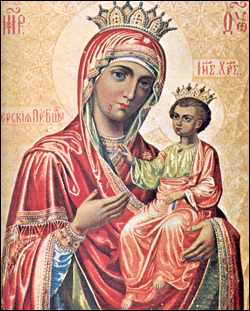|
On February 25th we celebrate the Iveron Icon of the Mother of God. This holy icon belonged to a pious widow who lived near the city of Nicea in the era of iconoclasm. When Emperor Theophilus the Iconoclast sent his soldiers throughout the realm to destroy all icons, a group of soldiers came to the house of this widow. One of them, seeing the holy icon, became enraged and smote with his sword the Holy Virgin’s cheek that was depicted on the icon. But to his horror, blood gushed forth from the wound. Awed by this miracle, the repentant soldier fell on his knees before the icon and abandoned his heresy, (and later became a monk). At his suggestion the widow decided to conceal the icon, in order to save it from desecration. After an earnest prayer to the Mother of God, the pious woman set the icon on the sea and with great joy saw the icon sailing on the waves directly towards the west.

Many years later this icon appeared in a tower of flame on the sea near the Iveron monastery on Mount Athos. At that time a certain elder from Georgia by the name of Gabriel lived in the Iveron monastery. The Holy Virgin appeared to him in a dream and ordered him to tell the abbot and the brothers that She wished to give them Her icon, in order to help them and protect them, while the elder Gabriel himself She commanded to fearlessly approach the icon and take it into his hands. In response to the Holy Virgin’s command, the elder Gabriel then walked on water as on land and brought the icon ashore. The monks greeted the icon with reverence and carried it to their monastery, placing it in the altar. On the following day they did not find the icon in the spot where it had been placed. After a long search they found it on the wall above the monastery gates and once more took it back to the altar, but the following morning they once again found it above the gates. This happened several times before the monks finally understood that it was not they who guarded the icon, but rather the holy icon guarded them. Consequently, a church was built above the monastery gates, in which the icon remains to this day. From the name of the monastery this holy icon began to be called the Iveron icon, while in accordance with its location it became known as “the Gatekeeper.”
In Russia there were several wonderworking copies of the holy Iveron icon. Especially revered was the Iveron icon in Moscow, which stood in the chapel at the Voskresensky gates. This miraculous icon, which worked a multitude of miracles, was revered not only by the inhabitants of Moscow, but by all of Russia. Everyone arriving in the capital, and especially members of the Imperial Family, hurried to visit the Iveron chapel and venerate the holy icon, in front of which molebens were served continuously. |